MSI MS-7599 User Manual
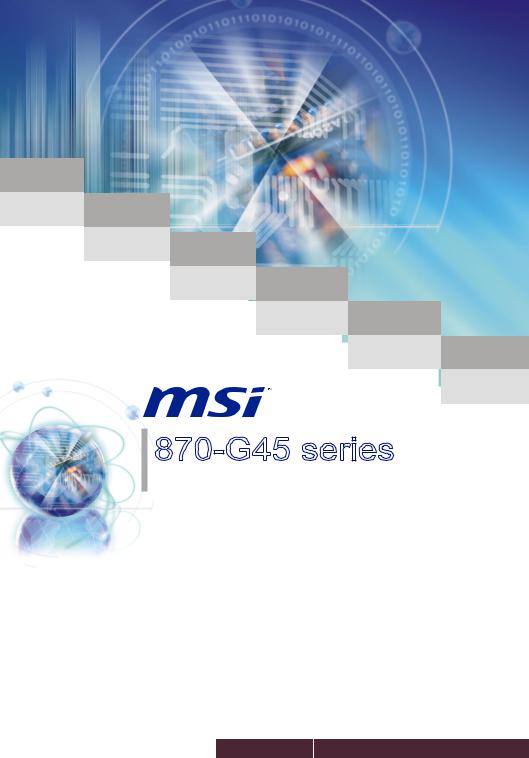
870-G45 series
MS-7599 (v2.x) Mainboard
G52-75991XG
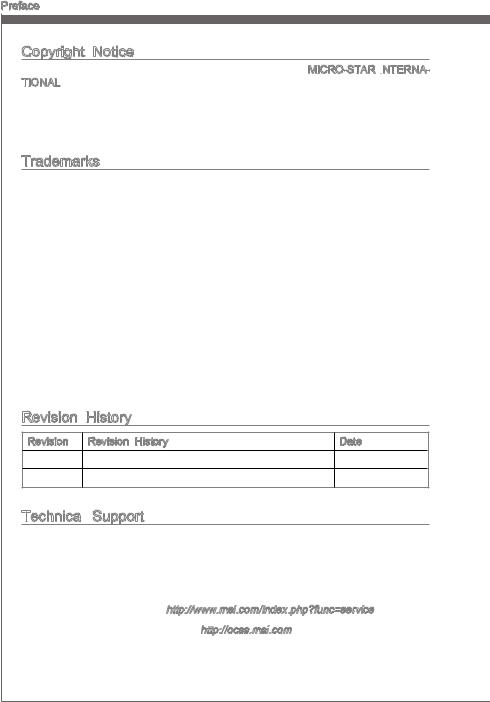
Preface
Copyright Notice
The material in this document is the intellectual property of MICRO-STAR INTERNA - TIONAL.
- TIONAL.
 We take every care in the preparation of this document, but no guarantee is given as to the correctness of its contents. Our products are under continual improvement and we reserve the right to make changes without notice.
We take every care in the preparation of this document, but no guarantee is given as to the correctness of its contents. Our products are under continual improvement and we reserve the right to make changes without notice.
Trademarks
All trademarks are the properties of their respective owners.
MSI® is registered trademark of Micro-Star Int’l Co.,Ltd.
NVIDIA® is registered trademark of NVIDIA Corporation.
ATI® is registered trademark of ATI Technologies, Inc.
AMD® is registered trademarks of AMD Corporation.
Intel® is registered trademarks of Intel Corporation.
Windows® is registered trademarks of Microsoft Corporation.
AMI® is registered trademark of American Megatrends Inc.
Award® is a registered trademark of Phoenix Technologies Ltd.
Sound Blaster® is registered trademark of Creative Technology Ltd.
Realtek® is registered trademark of Realtek Semiconductor Corporation.
JMicron® is registered trademark of JMicron Technology Corporation.
Netware® is a registered trademark of Novell, Inc.
Revision |
History |
|
Revision |
Revision History |
Date |
V2.1 |
Update for Europe Version |
May 2010 |
Technical
 Support
Support
If a problem arises with your system and no solution can be obtained from the user’s manual, please contact your place of purchase or local distributor. Alternatively, please try the following help resources for further guidance.
◙Visit the MSI website for FAQ, technical guide, BIOS updates, driver updates, and other information: http://www.msi.com/index.php?func=service
◙Contact our technical staff at: http://ocss.msi.com
ii

MS-7599
Safety Instructions
Always read the safety instructions carefully.
Keep this User’s Manual for future reference.
Keep this equipment away from humidity.
Lay this equipment on a reliable flat surface before setting it up.
The openings on the enclosure are for air convection hence protects the equipment from overheating. DO NOT COVER THE OPENINGS.
Make sure the voltage of the power source and adjust properly 110/220V before connecting the equipment to the power inlet.
Place the power cord such a way that people can not step on it. Do not place anything over the power cord.
Always Unplug the Power Cord before inserting any add-on card or module.
All cautions and warnings on the equipment should be noted.
Never pour any liquid into the opening that could damage or cause electrical shock.
If any of the following situations arises, get the equipment checked by service personnel:
The power cord or plug is damaged.
Liquid has penetrated into the equipment.
The equipment has been exposed to moist ure.
The equipment does not work well or you can not get it work according to User’s Manual.
The equipment has dropped and damaged.
The equipment has obvious sign of breakage.
DO NOT LEAVE THIS EQUIPMENT IN AN ENVIRONMENT UNCONDITIONED, STORAGETEMPERATUREABOVE600 C(1400F),ITMAYDAMAGETHEEQUIPMENT.
CAUTION: Danger of explosion if battery is incorrectly replaced.
Replace only with the same or equivalent type recommended by the manufacturer.
:
使用者會被要求採取某些適當的對策。
For better environmental protection, waste batteries should be collected separately for recycling special disposal.
Preface
iii
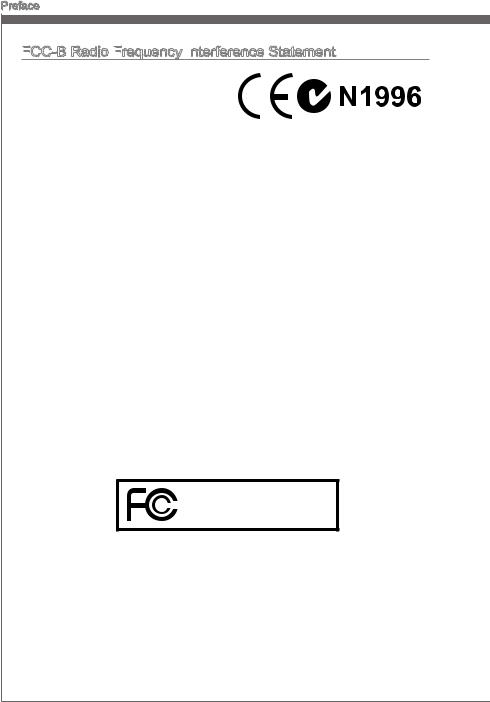
Preface
FCC
 -B Radio Frequency
-B Radio Frequency
 Interference
Interference Statement
Statement
This equipment has been tested and found to comply with the limits for a Class B digi-
tal device, pursuant to Part 15 of the FCC Rules. These limits are designed to provide reasonable protection against harmful inter-
ference in a residential installation. This equipment generates, uses and can radiate radio frequency energy and, if not installed and used in accordance with the instructions, may cause harmful interference to radio communications. However, there is no guarantee that interference will not occur in a particular installation. If this equipment does cause harmful interference to radio or television reception, which can be determined by turning the equipment off and on, the user is encouraged to try to correct the interference by one or more of the measures listed below.
Reorient or relocate the receiving antenna.
Increase the separation between the equipment and receiver.
Connect the equipment into an outlet on a circuit different from that to which the receiver is connected.
Consult the dealer or an experienced radio/television technician for help.
Notice 1
The changes or modifications not expressly approved by the party responsible for compliance could void the user’s authority to operate the equipment.
Notice 2
Shielded interface cables and A.C. power cord, if any, must be used in order to comply with the emission limits.
VOIR LA NOTICE D’INSTALLATION AVANT DE RACCORDER AU RESEAU.
Micro-Star International
MS-7599
This device complies with Part 15 of the FCC Rules. Operation is subject to the following two conditions:
1)this device may not cause harmful interference, and
2)this device must accept any interference received, including interference that may cause undesired operation.
iv
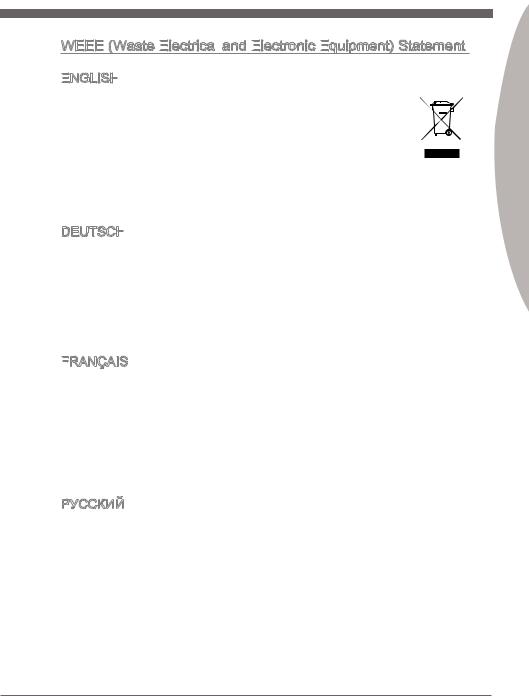
MS-7599
WEEE (Waste Electrical
(Waste Electrical

 and Electronic
and Electronic
 Equipment)
Equipment)
 Statement
Statement
ENGLISH


To protect the global environment and as an environmentalist, MSI must remind you that...
Under the European Union (“EU”) Directive on Waste Electrical and Electronic Equipment, Directive 2002/96/EC, which takes effect on August 13, 2005, products of “electrical and electronic equipment” cannot be discarded
as municipal waste anymore and manufacturers of covered electronic equip-
ment will be obligated to take back such products at the end of their useful life. MSI will comply with the product take back requirements at the end of life of MSI-branded products that are sold into the EU. You can return these products to local collection points.
DEUTSCH
Hinweis von MSI zur Erhaltung und Schutz unserer Umwelt
Gemäß der Richtlinie 2002/96/EG über Elektround Elektronik-Altgeräte dürfen Elektro- und Elektronik-Altgeräte nicht mehr als kommunale Abfälle entsorgt werden. MSI hat europaweit verschiedene Sammelund Recyclingunternehmen beauftragt, die in die Europäische Union in Verkehr gebrachten Produkte, am Ende seines Lebenszyklus zurückzunehmen. Bitte entsorgen Sie dieses Produkt zum gegebenen Zeitpunkt ausschliesslich an einer lokalen Altgerätesammelstelle in Ihrer Nähe.
FRANÇAIS

En tant qu’écologiste et afin de protéger l’environnement, MSI tient à rappeler ceci...
Au sujet de la directive européenne (EU) relative aux déchets des équipement électriques et électroniques, directive 2002/96/EC, prenant effet le 13 août 2005, que les produits électriques et électroniques ne peuvent être déposés dans les décharges ou tout simplement mis à la poubelle. Les fabricants de ces équipements seront obligés de récupérer certains produits en fin de vie. MSI prendra en compte cette exigence relative au retour des produits en fin de vie au sein de la communauté européenne. Par conséquent vous pouvez retourner localement ces matériels dans les points de collecte.
РУССКИЙ
Компания MSI предпринимает активные действия по защите окружающей среды, поэтому напоминаем вам, что....
В соответствии с директивой Европейского Союза (ЕС) по предотвращению загрязнения окружающей среды использованным электрическим и электронным оборудованием (директива WEEE 2002/96/EC), вступающей в силу 13
августа 2005 года, изделия, относящиеся к электрическому и электронному оборудованию, не могут рассматриваться как бытовой мусор, поэтому производители вышеперечисленного электронного оборудования обязаны принимать его для переработки по окончании срока службы. MSI обязуется соблюдать требования по приему продукции, проданной под маркой MSI на территории EC, в переработку по окончании срока службы. Вы можете вернуть эти изделия в специализированные пункты приема.
Preface

Preface
ESPAÑOL


MSI como empresa comprometida con la protección del medio ambiente, recomienda:
Bajo la directiva 2002/96/EC de la Unión Europea en materia de desechos y/o equipos electrónicos, con fecha de rigor desde el 13 de agosto de 2005, los productos clasificados como “eléctricos y equipos electrónicos” no pueden ser depositados en los contenedores habituales de su municipio, los fabricantes de equipos electrónicos, están obligados a hacerse cargo de dichos productos al termino de su período de vida. MSI estará comprometido con los términos de recogida de sus productos vendidos en la Unión Europea al final de su periodo de vida. Usted debe depositar estos productos en el punto limpio establecido por el ayuntamiento de su localidad o entregar a una empresa autorizada para la recogida de estos residuos.
NEDERLANDS
Om het milieu te beschermen, wil MSI u eraan herinneren dat….
De richtlijn van de Europese Unie (EU) met betrekking tot Vervuiling van Electrische en Electronische producten (2002/96/EC), die op 13 Augustus 2005 in zal gaan kunnen niet meer beschouwd worden als vervuiling. Fabrikanten van dit soort producten worden verplicht om producten retour te nemen aan het eind van hun levenscyclus. MSI zal overeenkomstig de richtlijn handelen voor de producten die de merknaam MSI dragen en verkocht zijn in de EU. Deze goederen kunnen geretourneerd worden op lokale inzamelingspunten.
SRPSKI
Da bi zaštitili prirodnu sredinu, i kao preduzeće koje vodi računa o okolini i prirodnoj sredini, MSI mora da vas podesti da…
Po Direktivi Evropske unije (“EU”) o odbačenoj ekektronskoj i električnoj opremi, Direktiva 2002/96/EC, koja stupa na snagu od 13. Avgusta 2005, proizvodi koji spadaju pod “elektronsku i električnu opremu” ne mogu više biti odbačeni kao običan otpad i proizvođači ove opreme biće prinuđeni da uzmu natrag ove proizvode na kraju njihovog uobičajenog veka trajanja. MSI će poštovati zahtev o preuzimanju ovakvih proizvoda kojima je istekao vek trajanja, koji imaju MSI oznaku i koji su prodati u EU. Ove proizvode možete vratiti na lokalnim mestima za prikupljanje.
POLSKI
Aby chronić nasze środowisko naturalne oraz jako firma dbająca o ekologię, MSI przypomina, że...
Zgodnie z Dyrektywą Unii Europejskiej (“UE”) dotyczącą odpadów produktów elektrycznych i elektronicznych (Dyrektywa 2002/96/EC), która wchodzi w życie 13 sierpnia 2005, tzw. “produkty oraz wyposażenie elektryczne i elektroniczne “ nie mogą być traktowane jako śmieci komunalne, tak więc producenci tych produktów będą zobowiązani do odbierania ich w momencie gdy produkt jest wycofywany z użycia. MSI wypełni wymagania UE, przyjmując produkty (sprzedawane na terenie Unii Europejskiej) wycofywane z użycia. Produkty MSI będzie można zwracać w wyznaczonych punktach zbiorczych.
vi

MS-7599
TÜRKÇE

Çevreci özelliğiyle bilinen MSI dünyada çevreyi korumak için hatırlatır:
Avrupa Birliği (AB) Kararnamesi Elektrik ve Elektronik Malzeme Atığı, 2002/96/EC Kararnamesi altında 13 Ağustos 2005 tarihinden itibaren geçerli olmak üzere, elektrikli ve elektronik malzemeler diğer atıklar gibi çöpe atılamayacak ve bu elektonik cihazların üreticileri, cihazların kullanım süreleri bittikten sonra ürünleri geri toplamakla yükümlü olacaktır. Avrupa Birliği’ne satılan MSI markalı ürünlerin kullanım süreleri bittiğinde MSI ürünlerin geri alınması isteği ile işbirliği içerisinde olacaktır. Ürünlerinizi yerel toplama noktalarına bırakabilirsiniz.
ČESKY
Záleží nám na ochraně životního prostředí - společnost MSI upozorňuje...
Podle směrnice Evropské unie (“EU”) o likvidaci elektrických a elektronických výrobků 2002/96/EC platné od 13. srpna 2005 je zakázáno likvidovat “elektrické a elektronické výrobky” v běžném komunálním odpadu a výrobci elektronických výrobků, na které se tato směrnice vztahuje, budou povinni odebírat takové výrobky zpět po skončení jejich životnosti. Společnost MSI splní požadavky na odebírání výrobků značky MSI, prodávaných v zemích EU, po skončení jejich životnosti. Tyto výrobky můžete odevzdat v místních sběrnách.
MAGYAR
Annak érdekében, hogy környezetünket megvédjük, illetve környezetvédőként fellépve az MSI emlékezteti Önt, hogy ...
Az Európai Unió („EU”) 2005. augusztus 13-án hatályba lépő, az elektromos és elektronikus berendezések hulladékairól szóló 2002/96/EK irányelve szerint az elektromos és elektronikus berendezések többé nem kezelhetőek lakossági hulladékként, és az ilyen elektronikus berendezések gyártói kötelessé válnak az ilyen termékek visszavételére azok hasznos élettartama végén. Az MSI betartja a termékvisszavétellel kapcsolatos követelményeket az MSI márkanév alatt az EU-n belül értékesített termékek esetében, azok élettartamának végén. Az ilyen termékeket a legközelebbi gyűjtőhelyre viheti.
ITALIANO

Per proteggere l’ambiente, MSI, da sempre amica della natura, ti ricorda che….
In base alla Direttiva dell’Unione Europea (EU) sullo Smaltimento dei Materiali Elettrici ed Elettronici, Direttiva 2002/96/EC in vigore dal 13 Agosto 2005, prodotti appartenenti alla categoria dei Materiali Elettrici ed Elettronici non possono più essere eliminati come rifiuti municipali: i produttori di detti materiali saranno obbligati a ritirare ogni prodotto alla fine del suo ciclo di vita. MSI si adeguerà a tale Direttiva ritirando tutti i prodotti marchiati MSI che sono stati venduti all’interno dell’Unione Europea alla fine del loro ciclo di vita. È possibile portare i prodotti nel più vicino punto di raccolta
Preface
vii

Preface
Contents
Copyright |
Notice |
ii |
Trademarks |
ii |
|
Revision |
History |
ii |
Technical |
Support |
ii |
Safety Instructions |
iii |
|
FCC-B Radio Frequency Interference Statement |
iv |
|
WEEE (Waste Electrical and Electronic Equipment) Statement |
v |
|
English |
|
En-1 |
Mainboard Specifications En-2
Quick Components Guide En-4
CPU (Central Processing Unit) En-5
Memory En-8
Power Supply En-10
Back Panel En-11
Connectors En-13
Jumpers En-19
Switch En-20
Slots En-21
LED Status Indicators En-24
BIOS Setup En-25
Software Information En-35
Deutsch De-1
Spezifikationen De-2
Komponenten-Übersicht De-4
CPU (Prozessor) De-5
Speicher De-8
Stromversorgung De-10
Rücktafel De-11
Anschlüssen De-13
Steckbrücke De-19
Schalter De-20
Steckplätze De-21
LED Statusdikatoren De-24
BIOS Setup De-25
Software-Information De-35
viii

MS-7599
Français
 Fr
Fr
 -1
-1
Spécifications Fr-2 Guide Rapide Des Composants Fr-4 Processeur : CPU Fr-5 Mémoire Fr-8 Connecteur d’Alimentation Fr-10 Panneau arrière Fr-11 Connecteurs Fr-13 Cavaliers Fr-19 Interrupteur Fr-20 Emplacements Fr-21 Indicateur de statut LED Fr-24 Réglage BIOS Fr-25 Information De Logiciel Fr-35
Русский Ru-1
Характеристики Ru-2 Размещение компонентов системной платы Ru-4 CPU (Центральный процессор) Ru-5 Память Ru-8 Разъем питания Ru-10 Задняя панель Ru-11 Коннекторы Ru-13 Перемычки Ru-19 Переключатели Ru-20 Слоты Ru-21 Световые индикаторы Ru-24 Настройка BIOS Ru-25 Сведения о программном обеспечении Ru-36
Preface
ix


English

870-G45 Series
Europe version

MS-7599 Mainboard
Mainboard Specifications
Processor Support
■AMD® PhenomTM II X4/ X3 and AthlonTM X4/ X3/ X2 processor in the AM3 package. (For the latest information about CPU, please visit http://www.msi.com/index. php?func=cpuform2)
HyperTransport

■ HyperTransport™ 3.0, supports up to 5.2 GT/s
Chipset
■North Bridge: AMD® RX780 chipset
■South Bridge: AMD® SB710 chipset
Memory Support
■DDR3 1600*(OC)/ 1333/ 1066/ 800 SDRAM (total 16 GB Max)
■4 DDR3 DIMMs (240-pin/ 1.5V)
(* OC= overclocking, for more information on compatible components, please visit http://www.msi.com/index.php?func=testreport)
LAN
■ Supports Gigabit LAN by ATHEROS® AR8131M
Audio
■Chip integrated by VIA® VT1828S
■Flexible 8-channels audio with jack sensing
■Compliant with Azalia 1.0 Spec
IDE


■1 IDE port by AMD® SB710
■Supports Ultra DMA 66/100/133 mode, PIO & Bus Master operation mode
SATA
■ 6 SATA 3Gb/s ports by AMD® SB710
RAID
■ SATA1~6 supports RAID 0/ 1/ 10 or JBOD mode by AMD® SB710
En-2

Floppy

■1 floppy port
■Supports 1 FDD with 360 KB, 720 KB, 1.2 MB, 1.44 MB and 2.88 MB
Connectors
■Back panel
-1 PS/2 keyboard
-1 PS/2 mouse port
-1 Serial port
-6 USB 2.0 ports
-1 LAN port
-6 flexible audio ports
■On-Board
-3 USB 2.0 connectors
-1 S/PDIF-out connector
-1 Front Panel Audio connector
-1 Chassis Intrusion connector
-1 CD-In connector
-1 TPM Module connector
-1 Easy OC switch
Slots
■1 PCI Express x16 slot (PCI_E2), supports up to PCI Express x16 speed
■1 PCI Express x16 slot (PCI_E3), supports up to PCI Express x4 speed
■1 PCI Express x1 slot
■3 PCI slots, support 3.3V/ 5V PCI bus Interface
Form Factor
Factor
■ ATX (21.0cm X 30.5 cm)
Mounting
■ 6 mounting holes
* If you need to purchase accessories and request the part numbers, you could search the product web page and find details on our web address http://www.msi.com/index. php
English
En-3

MS-7599 Mainboard
Quick Components Guide |
|
|
SYSFAN1, En-15 |
CPUFAN, En-15 |
|
|
|
|
JPWR2, En-10 |
CPU, En-5 |
DDR3, En-8 |
BackPanel, |
|
|
En-11 |
|
|
|
|
SYSFAN2, En-15 |
|
|
JPWR1, En-10 |
OC_SW1, En-20 |
|
JTPM1, En-18 |
|
|
|
PCIE, En-21 |
|
IDE1, En-13 |
|
|
|
JCI1, En-14 |
|
|
|
|
SATA, En-14 |
PCI, En-21 |
|
JBAT1, En-19 |
|
|
JFP1/ JFP2, |
|
|
En-16 |
JCD1, En-15 |
JUSB1~3, En-17 |
|
FDD1, En-13 |
|
|
JSP1, En-16 |
|
|
JAUD1, En-17 |
|
|
En-4 |
|
|
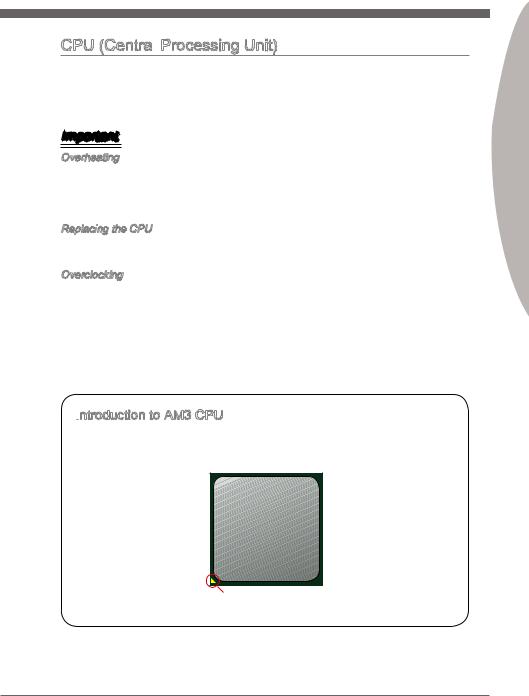
CPU (Central Processing Unit)
Processing Unit)
When you are installing the CPU, make sure to install the cooler to prevent overheating. If you do not have the CPU cooler, consult your dealer before turning on the computer.
For the latest information about CPU, please visit http://www.msi.com/index. php?func=cpuform2
Important
Overheating
Overheating will seriously damage the CPU and system. Always make sure the cooling fan can work properly to protect the CPU from overheating. Make sure that you apply an even layer of thermal paste (or thermal tape) between the CPU and the heatsink to enhance heat dissipation.
Replacing the CPU
While replacing the CPU, always turn off the ATX power supply or unplug the power supply’s power cord from the grounded outlet first to ensure the safety of CPU.
Overclocking
This mainboard is designed to support overclocking. However, please make sure your components are able to tolerate such abnormal setting, while doing overclocking. Any attempt to operate beyond product specifications is not recommended. We do not guarantee the damages or risks caused by inadequate operation or beyond product specifications.
Introduction
 to AM3 CPU
to AM3 CPU
The surface of CPU. Remember to apply some thermal paste on it for better heat dispersion.
Gold arrow
English
En-5

MS-7599 Mainboard
CPU & Cooler Installation
When you are installing the CPU, make sure the CPU has a cooler attached on the top to prevent overheating. Meanwhile, do not forget to apply some thermal paste on CPU before installing the heat sink/cooler fan for better heat dispersion.
Follow the steps below to install the CPU & cooler correctly. Wrong installation will cause the damage of your CPU & mainboard
1.Pull the lever sideways away from the socket. Make sure to raise the lever up to a 90-degree angle.
2.Look for the gold arrow of the CPU. Thegoldarrowshouldpointasshown in the picture. The CPU can only fit in the correct orientation.
3.If the CPU is correctly installed, the pins should be completely embedded into the socket and can not be seen. Please note that any violation of the correct installation procedures may cause permanent damages to your mainboard.
4.Press the CPU down firmly into the socket and close the lever. As the CPU is likely to move while the lever is being closed, always close the lever with your fingers pressing tightly on top of the CPU to make sure the CPU is properly and completely embedded into the socket.
En-6
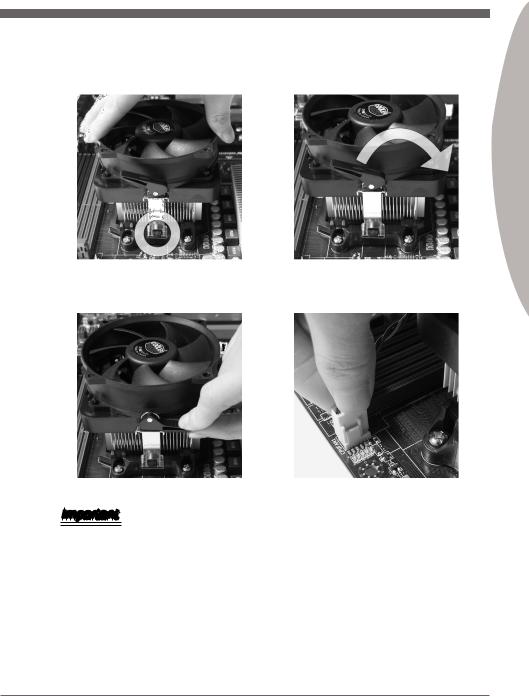
5.Position the cooling set onto the retention mechanism.
Hook one end of the clip to hook first.
6.Then press down the other end of the clip to fasten the cooling set on the top of the retention mechanism.
Locate the Fix Lever and lift up it.
English
7. Fasten down the lever. |
8. AttachtheCPUFancabletotheCPU |
|
fan connector on the mainboard. |
Important
•Mainboard photos shown in this section are for demonstration only. The appearance of your mainboard may vary depending on the model you purchase.
•While disconnecting the Safety Hook from the fixed bolt, it is necessary to keep an eye on your fingers, because once the Safety Hook is disconnected from the fixed bolt, the fixed lever will spring back instantly.
En-7
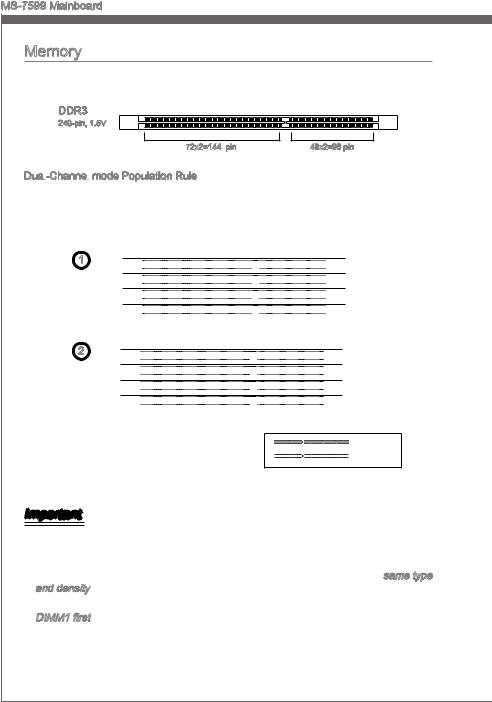
MS-7599 Mainboard
Memory
These DIMM slots are used for installing memory modules. For more information on compatible components, please visit http://www.msi.com/index.php?func=testreport
DDR3
240-pin, 1.5V
72x2=144 pin |
48x2=96 pin |
Dual
 -Channel
-Channel
 mode Population Rule
mode Population Rule
In Dual-Channel mode, the memory modules can transmit and receive data with two data bus lines simultaneously. Enabling Dual-Channel mode can enhance the system performance. The following illustrations explain the population rules for Dual-Channel mode.
1



























































































































































































 DIMM1
DIMM1




























































































































































































 DIMM2
DIMM2


 DIMM3
DIMM3


 DIMM4
DIMM4
2



























































































































































































 DIMM1
DIMM1




























































































































































































 DIMM2
DIMM2




























































































































































































 DIMM3
DIMM3




























































































































































































 DIMM4
DIMM4





























































































































































































 Installed
Installed
 Empty
Empty
Important
•DDR3 memory modules are not interchangeable with DDR2 and the DDR3 standard is not backwards compatible. You should always install DDR3 memory modules in the DDR3 DIMM slots.
•In Dual-Channel mode, make sure that you install memory modules of the same type and density in different channel DIMM slots.
•To enable successful system boot-up, always insert the memory modules into the DIMM1 first.
•Due to the chipset resource deployment, the system density will only be detected up to 15+GB (not full 16GB) when each DIMM is installed with a 4GB memory module.
En-8

Installing Memory Modules
Memory Modules
1.The memory module has only one notch on the center and will only fit in the right orientation.
2.Insert the memory module vertically into the DIMM slot. Then push it in until the golden finger on the memory module is deeply inserted in the DIMM slot. The plastic clip at each side of the DIMM slot will automatically close when the memory module is properly seated.
3.Manually check if the memory module has been locked in place by the DIMM slot clips at the sides.
Important
You can barely see the golden finger if the memory module is properly inserted in the DIMM slot.
English
Notch
Volt
En-9
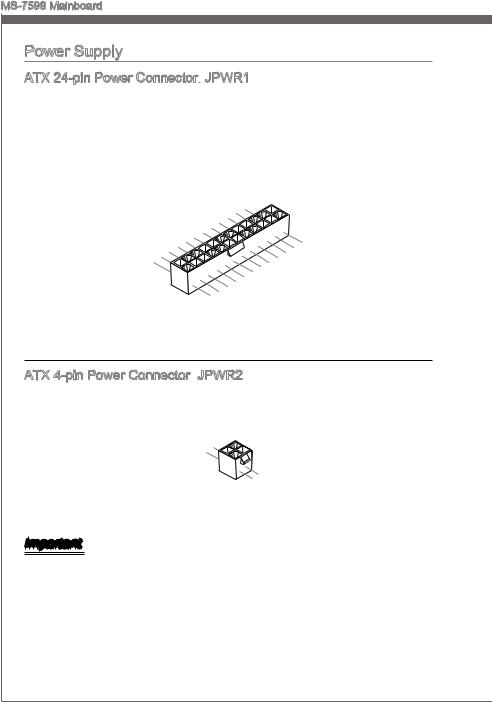
MS-7599 Mainboard
Power Supply
ATX 24-pin Power Connector: JPWR1
JPWR1
This connector allows you to connect an ATX 24-pin power supply. To connect the ATX 24-pin power supply, make sure the plug of the power supply is inserted in the proper orientation and the pins are aligned. Then push down the power supply firmly into the connector.
You may use the 20-pin ATX power supply as you like. If you’d like to use the 20-pin ATX power supply, please plug your power supply along with pin 1 & pin 13.
|
|
|
|
|
|
|
|
12 |
. |
|
|
|
|
|
|
|
|
|
||
|
|
|
|
|
|
|
11 |
|
|
|
|
|
|
|
|
|
|
|
||
|
|
|
|
|
|
|
. +3. |
|
|
|
|
|
|
|
||||||
|
|
|
|
|
|
|
10 |
|
|
|
|
|
|
|
|
|||||
|
|
|
|
|
|
9 . |
+12V |
3 |
|
|
|
|
|
|
||||||
|
|
|
|
|
|
8 |
. |
|
|
|
|
|
|
|
|
|||||
|
|
|
|
|
|
|
|
|
|
V |
|
|
|
|
|
|
||||
|
|
|
|
|
|
7 |
|
|
|
|
|
|
|
|
|
|
|
|
||
|
|
|
|
|
6 . |
|
|
|
|
|
|
|
|
|
|
|
|
|
|
|
|
|
|
|
5 . |
|
|
|
|
|
|
|
|
|
|
|
|
|
|
||
|
|
|
4 |
. +5 |
|
|
|
|
|
|
|
|
|
|
|
|
|
|
||
2 |
3 . |
|
|
|
|
|
|
|
|
|
|
|
|
|
|
|
|
|||
|
. +5 |
V |
|
|
|
|
|
|
|
|
|
|
|
|
|
|
||||
1 |
. |
|
|
|
|
|
|
|
|
|
|
|
|
|
|
|
|
|
||
|
|
|
|
Ground |
|
|
|
|
|
|
|
|
|
|
|
|
|
|
||
. +3 |
. |
|
|
|
|
|
|
|
|
|
|
|
|
|
|
|
|
|||
+3 |
|
|
|
|
|
|
|
|
|
|
|
|
|
|
24 |
|
|
|||
|
|
3 |
|
|
|
|
|
|
|
|
|
|
|
|
|
|
||||
|
|
.GroundV |
|
|
|
|
|
|
|
|
|
|
. |
|||||||
|
|
3 |
|
|
|
|
|
|
|
|
|
|
|
|
|
|
||||
|
|
|
|
V |
|
|
|
|
|
|
|
|
|
|
|
23. |
|
|||
|
|
|
|
|
|
|
|
|
|
|
|
|
|
|
|
. +5 |
||||
|
|
|
|
|
|
|
|
|
|
|
|
|
|
|
|
+5 |
|
|
GroundV |
|
|
|
|
|
|
|
|
|
|
|
|
|
|
|
|
|
+5 |
V |
V |
||
|
|
|
|
|
|
|
|
|
|
|
|
|
|
|
|
|
|
|
|
|
|
|
|
|
|
|
|
|
|
|
|
|
. |
- |
|
|
|
|
|
||
|
|
|
|
|
|
|
|
|
|
13. |
- |
ON |
|
|
|
|
||||
|
|
|
|
|
|
|
|
|
|
|
12V |
|
|
|
|
|||||
|
|
|
|
|
|
|
|
|
|
|
+3 |
|
# |
|
|
|
|
|||
|
|
|
|
|
|
|
|
|
|
|
|
|
|
.Ground |
|
|
|
|
|
|
|
|
|
|
|
|
|
|
|
|
|
|
|
|
3 |
|
|
|
|
|
|
|
|
|
|
|
|
|
|
|
|
|
|
|
|
V |
|
|
|
|
|
|
ATX 4-pin Power Connector: JPWR2
JPWR2
This connector is used to provide power to the CPU.
|
1 |
|
2 |
. |
|
. |
|
|
|
Ground |
|
Ground |
|
|
|
|
3 |
|
|
. |
|
4 |
+12V |
|
. |
|
|
+12V |
|
Important
•Make sure that all the connectors are connected to proper ATX power supplies to ensure stable operation of the mainboard.
En-10
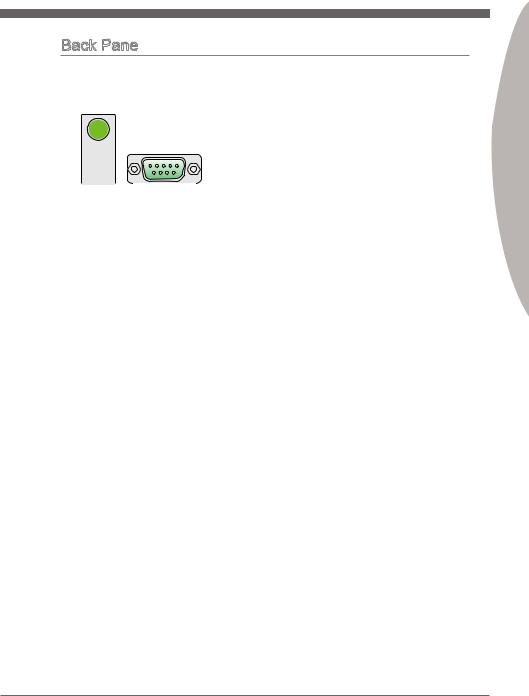
Back Panel
|
|
|
LAN |
|
|
|
USB Port |
USB Port |
Line-In |
RS-Out |
English |
|
|
|
|||
|
|
|
Line-Out CS-Out |
||
|
|
|
Mic |
SS-Out |
|
|
|
|
|
||
Mouse/Keyboard |
Serial Port |
|
USB Port |
|
|
Mouse/Keyboard
The standard PS/2® mouse/keyboard DIN connector is for a PS/2® mouse/keyboard.Serial Port
Port
The serial port is a 16550A high speed communications port that sends/ receives 16 bytes FIFOs. You can attach a serial mouse or other serial devices directly to the connector.
USB Port
The USB (Universal Serial Bus) port is for attaching USB devices such as keyboard, mouse, or other USB-compatible devices.
LAN
The standard RJ-45 LAN jack is for connection to Yellow |
Green/ Orange |
|||
the Local Area Network (LAN). You can connect a |
|
|||
network cable to it. |
|
|
||
LED |
Color |
LED State |
Condition |
|
Left |
Yellow |
Off |
LAN link is NOT established. |
|
|
|
On(Steady state) |
LAN link is established. |
|
|
|
On(brighter & pulsing) |
The computer is communicating with another computer on the LAN. |
|
Right |
Green |
Off |
10 Mbits/sec data rate is selected. |
|
|
|
On |
100 Mbits/sec data rate is selected. |
|
|
Orange |
On |
1000 Mbits/sec data rate is selected. |
|
En-11

MS-7599 Mainboard
Audio Ports
These audio connectors are used for audio devices. It is easy to differentiate between audio effects according to the color of audio jacks.
■Line-In (Blue) - Line In, is used for external CD player, tape-player or other audio devices.
■Line-Out (Green) - Line Out, is a connector for speakers or headphones.
■Mic (Pink) - Mic, is a connector for microphones.
■RS-Out (Black) - Rear-Surround Out in 4/ 5.1/ 7.1 channel mode.
■CS-Out (Orange) - Center/ Subwoofer Out in 5.1/ 7.1 channel mode.
■SS-Out (Gray) - Side-Surround Out 7.1 channel mode.
En-12
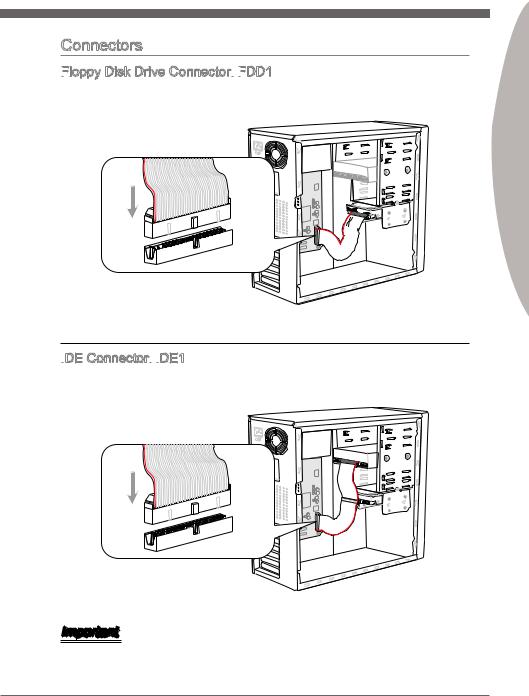
Connectors
Floppy
 Disk Drive Connector:
Disk Drive Connector:
 FDD1
FDD1

This connector supports 360 KB, 720 KB, 1.2 MB, 1.44 MB or 2.88 MB floppy disk drive.
English
* The MB layout in this figure is for reference only.
IDE

 Connector:
Connector:
 IDE1
IDE1

This connector supports IDE hard disk drives, optical disk drives and other IDE devices.
* The MB layout in this figure is for reference only.
Important
If you install two IDE devices on the same cable, you must configure the drives separately to master / slave mode by setting jumpers. Refer to IDE device’s documentation supplied by the vendors for jumper setting instructions.
En-13

MS-7599 Mainboard
Serial
 ATA Connector:
ATA Connector:
 SATA1~6
SATA1~6
This connector is a high-speed Serial ATA interface port. Each connector can connect to one Serial ATA device.
* The MB layout in this figure is for reference only.
Important
Please do not fold the Serial ATA cable into 90-degree angle. Otherwise, data loss may occur during transmission.
Chassis Intrusion
 Connector:
Connector:
 JCI1
JCI1
This connector connects to the chassis intrusion switch cable. If the chassis is opened, the chassis intrusion mechanism will be activated. The system will record this status and show a warning message on the screen. To clear the warning, you must enter the BIOS utility and clear the record.
|
2 |
|
|
|
|
||
1 |
|
. |
|
|
|
|
|
|
|
G |
|
|
|
||
. |
|
|
r |
|
|
||
C |
|
|
o |
|
|
||
|
|
I |
|
u |
|
||
|
|
|
N |
|
n |
||
|
|
|
|
T |
|
d |
|
|
|
|
|
|
R |
|
|
|
|
|
|
|
U |
||
En-14
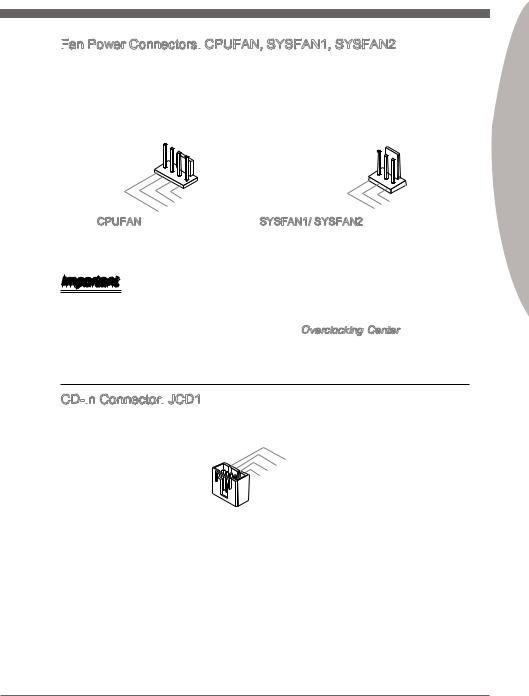
Fan
 Power Connectors:
Power Connectors:
 CPUFAN, SYSFAN1, SYSFAN2
CPUFAN, SYSFAN1, SYSFAN2
The fan power connectors support system cooling fan with +12V. When connecting the wire to the connectors, always note that the red wire is the positive and should be connected to the +12V; the black wire is Ground and should be connected to GND. If the mainboard has a System Hardware Monitor chipset on-board, you must use a specially designed fan with speed sensor to take advantage of the CPU fan control.
English
CPUFAN
|
|
|
|
1 |
|
|
|
|
|
|
|
2 . |
|
|
|
||||
3 |
. G |
|
|
|
|||||
|
+ r |
|
|
||||||
4 |
. |
1 o |
|
|
|||||
|
S |
|
2 u |
|
|||||
. |
|
e |
|
|
|
n |
|||
C |
|
n V |
|
d |
|||||
|
|
o |
|
s |
|
|
|
||
|
|
|
n |
|
o |
|
|
||
|
|
|
|
t |
|
r |
|
|
|
|
|
|
|
r |
|
|
|
||
|
|
|
|
|
o |
|
|
|
|
|
|
|
|
|
|
l |
|
|
|
SYSFAN1/ SYSFAN2
|
|
|
1 |
|
|
|
|
|
|
2 . |
|
|
|
|
|||||
|
. G |
|
|
|
|||||
3 |
|
+ |
|
|
r |
|
|
||
|
|
|
o |
|
|
||||
. |
|
1 |
|
u |
|
||||
S |
|
2 |
|
||||||
|
|
e |
|
n |
|||||
|
|
|
|
V |
|
d |
|||
|
|
|
n |
|
|
|
|
||
|
|
|
|
s |
|
|
|
||
|
|
|
|
|
o |
|
|
||
|
|
|
|
|
|
r |
|
|
|
Important
•Please refer to the recommended CPU fans at processor’s official website or consult the vendors for proper CPU cooling fan.
•CPUFAN supports fan control. You can install Overclocking Center utility that will automatically control the CPU fan speed according to the actual CPU temperature.
•Fan cooler set with 3 or 4 pins power connector are both available for CPUFAN.
CD-In
 Connector:
Connector:
 JCD1
JCD1
This connector is provided for external audio input.
|
|
|
|
|
1 |
|
|
|
|
|
|
|
|
2 |
|
. |
|
|
|
||
|
|
|
|
L |
|
|
||||
|
3 |
|
. |
|
|
|
|
|
||
|
|
|
G |
|
|
|
|
|||
4 |
|
. |
|
|
r |
|
|
|||
|
|
G |
|
|
o |
|
|
|||
. |
|
|
r |
|
u |
|
||||
R |
|
|
o |
|
|
n |
||||
|
|
|
|
|
|
u |
|
|
d |
|
|
|
|
|
|
|
|
n |
|
||
|
|
|
|
|
|
|
|
d |
|
|
En-15
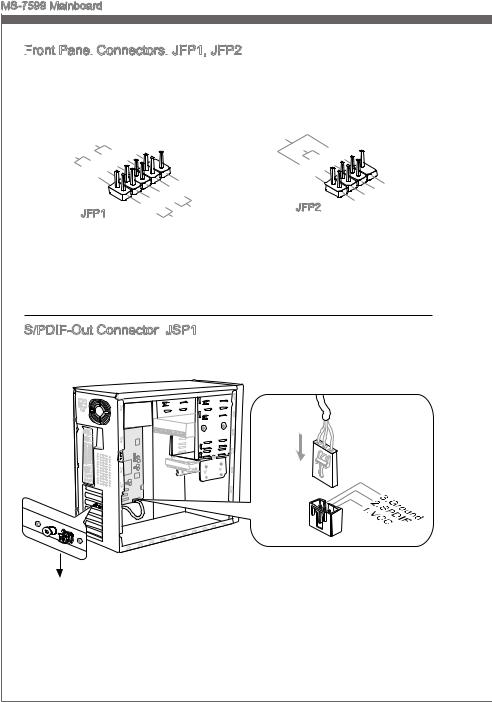
MS-7599 Mainboard
Front
 Panel
Panel
 Connectors:
Connectors:
 JFP1, JFP2
JFP1, JFP2
These connectors are for electrical connection to the front panel switches and LEDs. The JFP1 is compliant with Intel® Front Panel I/O Connectivity Design Guide.
|
P |
|
|
|
|
|
|
|
|
|
|
|
P |
ower |
S |
10 |
|
|
|
|
|
|
|||
|
|
witch |
|
No |
|
|
|
|||||
ower |
|
|
|
|
|
|
|
|
||||
|
|
|
|
|
|
|
. |
|
|
Pi |
||
|
|
LE |
|
|
|
|
|
8 |
||||
|
|
D |
|
|
|
|
|
n |
||||
|
|
|
|
|
6 |
|
- |
|
||||
|
|
|
4 |
|
|
. |
. |
|
||||
|
|
|
|
|
+ |
|
|
|
||||
|
|
|
2 |
. |
|
|
|
|
|
|||
|
|
|
|
- |
|
|
|
|
||||
|
|
|
. |
|
|
|
|
|
|
|
|
|
|
|
|
+ |
|
|
|
|
|
|
|
|
|
JFP1
|
|
|
|
|
|
|
|
9 |
|
|
|
|
||
1 |
|
|
|
|
|
|
|
|
. |
|
|
|
|
|
|
|
|
|
7 |
|
|
Reserve |
|
||||||
|
|
|
5 |
|
. |
|
|
|
|
|
|
|||
|
|
|
|
|
+ |
|
|
|
|
|
||||
|
3 |
. |
|
|
|
|
|
|
|
|
|
|||
|
|
- |
|
|
|
|
|
|
|
|
||||
|
|
. |
|
|
|
|
|
|
|
|
|
|
|
|
. |
- |
|
|
|
|
|
|
Reset |
|
d |
||||
+ |
|
|
|
|
|
|
|
|
|
|||||
|
|
|
HDD |
|
|
|
|
|||||||
|
|
|
|
|
|
LE |
|
S |
||||||
|
|
|
|
|
|
|
|
|
|
|
D |
|
witch |
|
|
|
|
|
|
|
|
|
|
|
|
|
|
|
|
Speaker |
|
|
6 |
|
+ |
|
Buzzer |
|
|
||||
|
|
|
|
|
8 |
|
|
|
|
|
|
. |
|
|
4 |
. |
|
|||
|
|
- |
|
|||
2 |
. |
|
|
|
||
|
+ |
|
|
|
||
. |
|
|
|
|
|
|
- |
|
|
|
|
|
|
JFP2
|
|
|
|
7 |
|
|
|
3 |
5 . |
|
|
||
|
|
. No |
|
|
||
|
|
. |
Power |
|
|
|
|
|
Pi |
D |
|||
1 |
|
Suspend |
|
|||
. |
|
|
|
n |
||
Ground |
LE |
|
||||
|
|
|
|
|
LE |
|
|
|
|
|
|
|
D |
S/PDIF
 -Out Connector:
-Out Connector: JSP1
JSP1
This connector is used to connect S/PDIF (Sony & Philips Digital Interconnect Format) interface for digital audio transmission.
* The MB layout in this figure is for reference only.
S/PDIF-Out Bracket (optional)
En-16
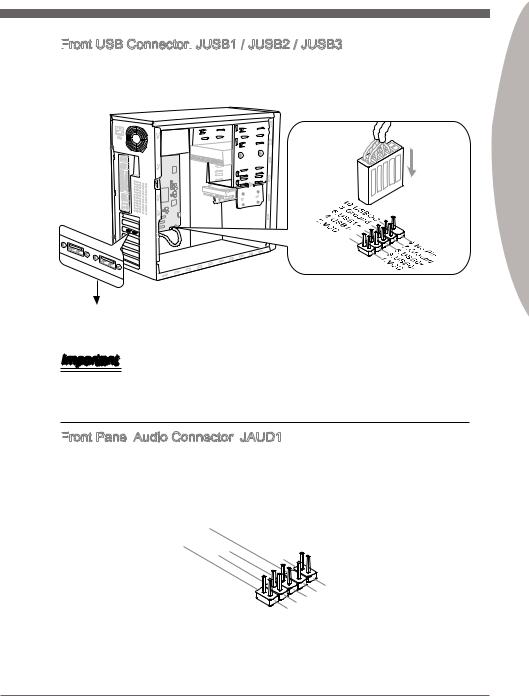
Front
 USB Connector:
USB Connector:
 JUSB1 / JUSB2 / JUSB3
JUSB1 / JUSB2 / JUSB3
This connector, compliant with Intel® I/O Connectivity Design Guide, is ideal for connecting high-speed USB interface peripherals such as USB HDD, digital cameras, MP3 players, printers, modems and the like.
English
* The MB layout in this figure is for reference only.
USB 2.0 Bracket (optional)
Important
Note that the pins of VCC and GND must be connected correctly to avoid possible damage.
Front Panel
Panel Audio Connector:
Audio Connector: JAUD1
JAUD1
This connector allows you to connect the front panel audio and is compliant with Intel® Front Panel I/O Connectivity Design Guide.
|
|
|
|
|
1 |
|
|
|
|
|
|
|
|
|
|
|
|
|
|
|
|
|
|
|
|
|
|
0 |
|
|
|
|
|
|
|
|
|
|
|
|
|
||
|
|
|
|
8 . |
|
|
|
|
|
|
|
|
|
|
|
|
|||||
|
|
6 |
|
. |
|
H |
|
|
|
|
|
|
|
|
|
|
|
||||
|
|
|
|
N |
|
|
e |
|
|
|
|
|
|
|
|
|
|
||||
|
4 |
. |
|
o |
|
|
a |
|
|
|
|
|
|
|
|
|
|||||
|
|
M |
|
|
P |
d |
|
|
|
|
|
|
|
||||||||
|
. |
|
|
I |
|
|
|
P |
|
|
|
|
|
|
|||||||
2 |
|
P |
|
|
C |
|
|
i |
|
|
|
|
|
|
|
|
|||||
|
|
|
|
|
|
n |
|
|
h |
|
|
|
|
|
|||||||
. |
|
R |
|
|
D |
|
|
|
|
|
|
o |
|
|
|
|
|||||
G |
|
|
E |
|
|
e |
|
|
|
|
|
n |
|
|
|
||||||
|
r |
|
|
|
S |
|
|
|
|
|
|
|
|
e |
|
|
|
||||
|
|
o |
|
|
|
|
|
|
t |
|
|
|
|
|
|
|
|
||||
|
|
|
|
E |
|
|
e |
|
|
|
|
|
D |
|
|
|
|||||
|
|
u |
|
|
|
|
c |
|
|
|
|
|
|
||||||||
|
|
|
|
n |
|
|
N |
|
|
|
i |
|
e |
|
|
||||||
|
|
|
|
|
d |
|
|
|
C |
|
t |
|
|
|
t |
|
|
||||
|
|
|
|
|
|
|
|
|
|
|
o |
|
|
|
|
||||||
|
|
|
|
|
|
|
|
|
|
|
|
|
|
|
e |
|
|
||||
|
|
|
|
|
|
|
|
|
|
|
E |
|
|
n |
|
c |
|
||||
|
|
|
|
|
|
|
|
|
|
|
|
|
|
|
|
|
t |
||||
|
|
|
|
|
|
|
|
|
|
|
|
# |
|
|
|
|
i |
||||
|
|
|
|
|
|
|
|
|
|
|
|
|
|
|
|
|
|
|
|
|
o |
|
|
|
|
|
|
|
|
|
|
|
|
|
|
|
|
|
|
|
|
|
n |
|
|
|
|
|
|
|
|
9 |
|
|
|
|
|
|
|
|
|
|
||
|
|
|
|
|
|
7 |
. |
|
|
|
|
|
|
|
|
|
||||
|
|
|
|
|
|
|
H |
|
|
|
|
|
|
|
|
|||||
|
|
|
5 |
|
. |
|
|
e |
|
|
|
|
|
|
|
|||||
|
|
|
|
|
S |
|
|
a |
|
|
|
|
|
|
||||||
|
3 |
|
. |
|
|
|
E |
|
|
|
|
|
|
|
||||||
|
|
|
|
H |
|
|
|
|
d |
|
|
|
|
|
||||||
1 |
|
. |
|
|
|
e |
|
N |
|
P |
|
|
|
|
||||||
|
|
M |
|
|
|
a |
|
|
S |
|
h |
|
|
|
||||||
. |
|
|
|
I |
|
|
|
d |
|
E |
|
o |
|
|
||||||
M |
|
|
|
C |
|
|
|
P |
|
_ |
|
n |
|
|||||||
|
|
I |
|
|
|
R |
|
|
S |
|
e |
|||||||||
|
|
|
C |
|
|
|
|
h |
|
|
||||||||||
|
|
|
|
|
|
L |
|
|
|
|
|
|
o |
|
E |
|
L |
|||
|
|
|
|
|
|
|
|
|
|
|
|
|
n |
|
N |
|
||||
|
|
|
|
|
|
|
|
|
|
|
|
|
|
|
|
e |
|
D |
||
|
|
|
|
|
|
|
|
|
|
|
|
|
|
|
|
|
R |
|
|
|
En-17

MS-7599 Mainboard
TPM Module connector: JTPM1
JTPM1
This connector connects to a TPM (Trusted Platform Module) module (optional). Please refer to the TPM security platform manual for more details and usages.
|
|
|
|
|
|
|
|
|
|
|
|
|
1 |
|
|
|
|
|
|
|
|
|
|
|
|
|
|
|
|
|
|
|
|
|
|
|
4 |
|
|
|
|
|
|
||
|
|
|
|
|
|
|
|
|
|
|
1 . |
|
|
|
|
|
||||||
|
|
|
|
|
|
|
1 |
|
2 |
|
|
G |
|
|
|
|
||||||
|
|
|
|
|
|
|
|
|
. |
|
|
|
r |
|
|
|||||||
|
|
|
|
|
|
|
|
|
0 |
|
|
G |
|
|
|
o |
|
|
||||
|
|
|
|
|
8 . |
|
|
r |
|
u |
|
|||||||||||
|
|
6 |
|
. |
|
N |
|
|
o |
|
|
n |
||||||||||
|
|
|
|
5 |
|
o |
|
|
|
u |
|
|
d |
|||||||||
4 |
|
. |
|
|
|
|
V |
|
P |
|
n |
|
||||||||||
|
|
S |
|
|
|
|
|
P |
|
|
i |
|
d |
|
||||||||
. |
|
|
|
e |
|
|
|
|
|
n |
|
|
|
|||||||||
|
3 |
|
|
|
|
r |
|
o |
|
|
|
|
|
|
|
|
||||||
2 . |
|
|
|
i |
|
w |
|
|
|
|
|
|
||||||||||
. |
|
|
3 |
|
|
|
|
a |
|
|
|
e |
|
|
|
|
||||||
3 |
|
|
|
|
V |
|
|
|
l |
|
|
|
|
|
|
|||||||
|
|
|
|
|
|
|
|
I |
|
|
|
r |
|
|
|
|||||||
V |
|
|
|
|
|
P |
|
R |
|
|
|
|
|
|
|
|
||||||
|
|
S |
|
|
|
|
|
Q |
|
|
|
|
|
|||||||||
|
|
|
|
t |
|
|
|
|
o |
|
|
|
|
|
|
|||||||
|
|
|
|
|
a |
|
|
|
|
w |
|
|
|
|
|
|
|
|
|
|||
|
|
|
|
|
|
n |
|
|
e |
|
|
|
|
|
|
|
|
|||||
|
|
|
|
|
|
|
|
|
d |
|
|
r |
|
|
|
|
|
|
||||
|
|
|
|
|
|
|
|
|
|
|
b |
|
|
|
|
|
|
|
|
|
|
|
|
|
|
|
|
|
|
|
|
|
|
|
y |
|
|
|
|
|
|
|
|
|
|
|
|
|
|
|
|
|
|
|
|
|
|
|
p |
|
|
|
|
|
|
|
||
|
|
|
|
|
|
|
|
|
|
|
|
|
|
o |
|
|
|
|
|
|||
|
|
|
|
|
|
|
|
|
|
|
|
|
|
|
w |
|
|
|
|
|||
|
|
|
|
|
|
|
|
|
|
|
|
|
|
|
|
|
|
e |
|
|
|
|
|
|
|
|
|
|
|
|
|
|
|
|
|
|
|
|
|
|
|
r |
|
|
|
|
|
|
|
|
|
|
|
|
|
|
|
|
|
1 |
|
|
|
|
|
|
|
|
|
|
|
|
|
|
|
|
|
|
|
|
|
|
|
|
|
|
|
|
|
|
|
|
|
|
|
|
|
|
|
|
|
|
3 |
|
|
|
|
|
|
|
|
|
|
|
|
|
|
|
|
|
|
|
|
|
|
|
|
||
|
|
|
|
|
|
|
|
|
|
|
1 . |
|
|
|
|
|
|
|
|
|
|
|
|
|
|
|
|
|
|
|
|
|
|||||||||
|
|
|
|
|
|
|
|
|
|
|
|
1 |
|
|
|
L |
|
|
|
|
|
|
|
|
|
|
|
|
|
|
|
|
|
|
|
|
|||||
|
|
|
|
|
|
|
|
9 |
|
|
|
. |
|
|
|
P |
|
|
|
|
|
|
|
|
|
|
|
|
|
|
|
|
|
|
|
||||||
|
|
|
|
|
|
|
|
|
|
|
L |
|
|
|
|
C |
|
|
|
|
|
|
|
|
|
|
|
|
|
|
|
|
|
||||||||
|
|
|
|
|
|
7 |
|
|
. |
|
|
|
P |
|
|
|
|
|
|
|
|
|
|
|
|
|
|
|
|
|
|
|
|||||||||
|
|
|
|
|
|
|
|
|
L |
|
|
|
|
|
|
F |
|
|
|
|
|
|
|
|
|
|
|
|
|
|
|
|
|||||||||
|
|
|
|
|
|
|
. |
|
|
P |
|
|
|
|
C |
|
|
|
|
|
|
|
|
|
|
|
|
|
|
|
|
|
|
||||||||
|
|
|
5 |
|
|
L |
|
|
|
C |
|
|
|
|
|
a |
|
|
a |
|
|
|
|
|
|
|
|
|
|
|
|
|
|||||||||
|
3 |
|
. |
|
P |
|
|
|
|
a |
|
|
|
d |
|
|
m |
|
|
|
|
|
|
|
|
|
|
|
|||||||||||||
|
|
|
L |
|
|
|
C |
|
|
|
|
|
|
|
|
|
|
|
|
|
|
|
|
|
|
||||||||||||||||
|
|
. |
|
|
|
P |
|
|
|
|
|
|
|
|
|
|
d |
|
|
d |
|
|
|
e |
|
|
|
|
|
|
|
|
|
||||||||
1 |
|
|
L |
|
|
|
C |
|
|
|
a |
|
|
|
|
|
d |
|
|
r |
|
|
|
|
|
|
|
|
|
|
|
|
|
||||||||
|
|
|
P |
|
|
|
|
|
|
|
|
|
|
|
|
e |
|
|
|
|
|
|
|
|
|
|
|
|
|
||||||||||||
. |
|
|
|
|
|
|
a |
|
d |
|
|
|
|
r |
|
|
|
s |
|
|
|
|
|
|
|
|
|
|
|
||||||||||||
L |
|
|
|
C |
|
|
|
|
|
|
d |
|
|
e |
|
|
|
|
|
|
|
|
|
|
|
|
|
|
|||||||||||||
|
P |
|
|
|
|
R |
|
d |
|
|
|
|
r |
|
s |
|
|
|
|
|
|
& |
|
|
|
|
|
|
|
||||||||||||
|
|
|
C |
|
|
|
|
|
d |
|
|
|
e |
|
|
s |
|
|
|
|
|
|
|
|
|
|
|
||||||||||||||
|
|
|
|
|
|
|
e |
|
|
r |
|
|
|
s |
|
|
|
& |
|
|
|
|
d |
|
|
|
|
|
|||||||||||||
|
|
|
|
|
C |
|
|
|
s |
|
e |
|
|
|
s |
|
|
|
|
d |
|
|
a |
|
|
|
|||||||||||||||
|
|
|
|
|
|
|
l |
|
|
|
e |
|
|
s |
|
|
& |
|
|
|
|
|
|
|
|||||||||||||||||
|
|
|
|
|
|
|
|
o |
|
|
|
t |
|
|
s |
|
|
|
|
|
|
a |
|
|
|
a |
|
|
|||||||||||||
|
|
|
|
|
|
|
|
|
c |
|
|
|
|
|
|
|
|
|
|
& |
|
|
d |
|
|
|
|
t |
|
|
|
|
|||||||||
|
|
|
|
|
|
|
|
|
|
|
k |
|
|
|
|
|
|
|
|
|
|
|
|
|
|
a |
|
|
a |
|
|
p |
|||||||||
|
|
|
|
|
|
|
|
|
|
|
|
|
|
|
|
|
|
|
|
|
|
|
|
d |
|
|
|
|
t |
|
|
|
p |
|
i |
||||||
|
|
|
|
|
|
|
|
|
|
|
|
|
|
|
|
|
|
|
|
|
|
|
|
|
|
|
|
|
a |
|
|
|
|
n |
|||||||
|
|
|
|
|
|
|
|
|
|
|
|
|
|
|
|
|
|
|
|
|
|
|
|
|
a |
|
|
|
|
|
|
i |
|
3 |
|||||||
|
|
|
|
|
|
|
|
|
|
|
|
|
|
|
|
|
|
|
|
|
|
|
|
|
|
|
t |
|
|
|
p |
|
|
n |
|
||||||
|
|
|
|
|
|
|
|
|
|
|
|
|
|
|
|
|
|
|
|
|
|
|
|
|
|
|
a |
|
|
|
|
i |
|
2 |
|
||||||
|
|
|
|
|
|
|
|
|
|
|
|
|
|
|
|
|
|
|
|
|
|
|
|
|
|
|
|
|
|
p |
|
|
n |
|
|
|
|
||||
|
|
|
|
|
|
|
|
|
|
|
|
|
|
|
|
|
|
|
|
|
|
|
|
|
|
|
|
|
|
|
|
i |
|
|
1 |
|
|
|
|||
|
|
|
|
|
|
|
|
|
|
|
|
|
|
|
|
|
|
|
|
|
|
|
|
|
|
|
|
|
|
|
|
n |
|
|
|
|
|
|
|||
|
|
|
|
|
|
|
|
|
|
|
|
|
|
|
|
|
|
|
|
|
|
|
|
|
|
|
|
|
|
|
|
|
|
0 |
|
|
|
|
|
||
En-18
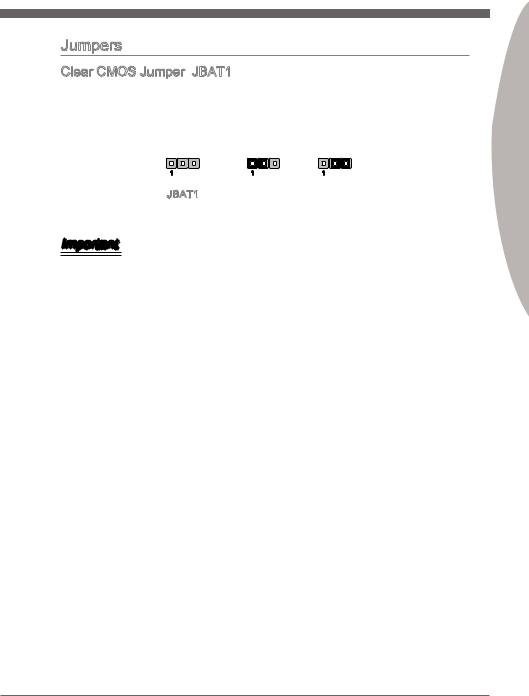
Jumpers
Clear CMOS Jumper: JBAT1
JBAT1
There is a CMOS RAM onboard that has a power supply from an external battery to keep the data of system configuration. With the CMOS RAM, the system can automatically boot OS every time it is turned on. If you want to clear the system configuration, set the jumper to clear data.
1 |
1 |
1 |
JBAT1 |
Keep Data |
Clear Data |
Important
You can clear CMOS by shorting 2-3 pin while the system is off. Then return to 1-2 pin position. Avoid clearing the CMOS while the system is on; it will damage the mainboard.
English
En-19
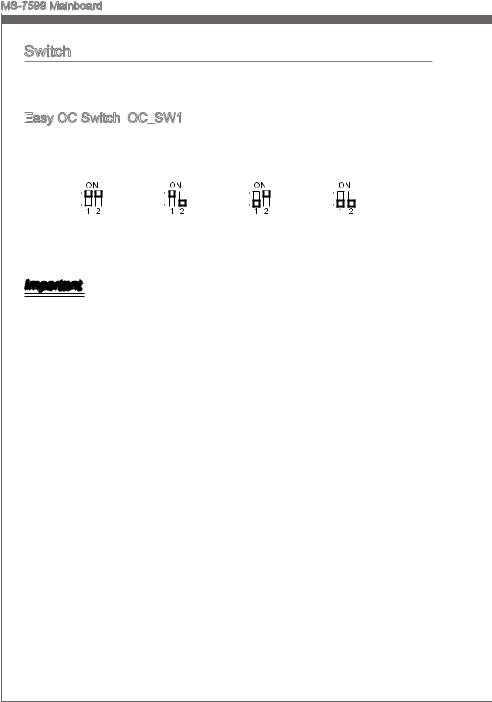
MS-7599 Mainboard
Switch
This mainboard provides the following switch for you to set the computer’s function. This section will explain how to change your mainboard’s function through the use of switch.
Easy
 OC Switch:
OC Switch: OC_SW1
OC_SW1
You can overclock the FSB to increase the processor frequency by changing the switch. Follow the instructions below to set the FSB.
|
|
|
|
|
|
|
|
|
|
|
|
|
|
|
|
|
|
|
|
|
|
|
|
|
|
|
|
|
|
|
|
|
|
|
|
|
|
|
|
|
|
|
|
|
|
|
|
|
|
|
|
|
|
|
|
|
|
|
|
|
|
|
|
|
|
|
|
|
|
|
|
|
|
|
|
|
|
|
|
|
|
|
|
Default |
Increase 10% |
Increase 15% |
Increase 20% |
||||||||||||||||||||||||
|
|
|
|
|
|
|
speed of FSB |
speed of FSB |
speed of FSB |
||||||||||||||||||
Important
•Make sure that you power off the system before setting the switch.
•When overclocking cause system instability or crash during boot. Please set the switch to default setting.
En-20
